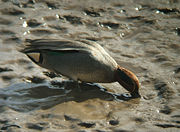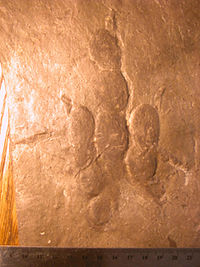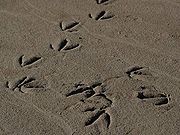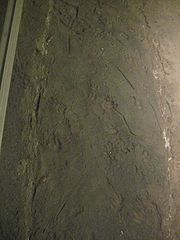
Bird ichnology
Encyclopedia

Ichnology
Ichnology is the branch of geology that deals with traces of organismal behavior, such as burrows and footprints. It is generally considered as a branch of paleontology; however, only one division of ichnology, paleoichnology, deals with trace fossils, while neoichnology is the study of modern traces...
is the study of avian
Bird
Birds are feathered, winged, bipedal, endothermic , egg-laying, vertebrate animals. Around 10,000 living species and 188 families makes them the most speciose class of tetrapod vertebrates. They inhabit ecosystems across the globe, from the Arctic to the Antarctic. Extant birds range in size from...
life traces in ornithology
Ornithology
Ornithology is a branch of zoology that concerns the study of birds. Several aspects of ornithology differ from related disciplines, due partly to the high visibility and the aesthetic appeal of birds...
and paleontology
Paleontology
Paleontology "old, ancient", ὄν, ὀντ- "being, creature", and λόγος "speech, thought") is the study of prehistoric life. It includes the study of fossils to determine organisms' evolution and interactions with each other and their environments...
. Such life traces can include footprint
Footprint
Footprints are the impressions or images left behind by a person walking. Hoofprints and pawprints are those left by animals with hooves or paws rather than feet, while "shoeprints" is the specific term for prints made by shoes...
s, nest
Nest
A nest is a place of refuge to hold an animal's eggs or provide a place to live or raise offspring. They are usually made of some organic material such as twigs, grass, and leaves; or may simply be a depression in the ground, or a hole in a tree, rock or building...
s, feces
Feces
Feces, faeces, or fæces is a waste product from an animal's digestive tract expelled through the anus or cloaca during defecation.-Etymology:...
and coproliths
Coprolite
A coprolite is fossilized animal dung. Coprolites are classified as trace fossils as opposed to body fossils, as they give evidence for the animal's behaviour rather than morphology. The name is derived from the Greek words κοπρος / kopros meaning 'dung' and λιθος / lithos meaning 'stone'. They...
. Scientists gain insight about the behavior
Behavior
Behavior or behaviour refers to the actions and mannerisms made by organisms, systems, or artificial entities in conjunction with its environment, which includes the other systems or organisms around as well as the physical environment...
and diversity
Biodiversity
Biodiversity is the degree of variation of life forms within a given ecosystem, biome, or an entire planet. Biodiversity is a measure of the health of ecosystems. Biodiversity is in part a function of climate. In terrestrial habitats, tropical regions are typically rich whereas polar regions...
of birds by studying such evidence.
Ichnofossils (or ichnites) are especially important for clarifying the evolution
Evolution
Evolution is any change across successive generations in the heritable characteristics of biological populations. Evolutionary processes give rise to diversity at every level of biological organisation, including species, individual organisms and molecules such as DNA and proteins.Life on Earth...
and prehistoric diversity of taxa. These cannot usually be associated with a particular genus
Genus
In biology, a genus is a low-level taxonomic rank used in the biological classification of living and fossil organisms, which is an example of definition by genus and differentia...
, let alone species
Species
In biology, a species is one of the basic units of biological classification and a taxonomic rank. A species is often defined as a group of organisms capable of interbreeding and producing fertile offspring. While in many cases this definition is adequate, more precise or differing measures are...
of bird, as hardly ever they are associated with fossil bones. But it is possible to group them into ichnotaxa based on their morphology (form). In practice, the details of shape that reveal the birds' behavior or biologic affinity are generally given more weight in ichnologic classification.
Bird ichnofossils



Mesozoic
The Mesozoic era is an interval of geological time from about 250 million years ago to about 65 million years ago. It is often referred to as the age of reptiles because reptiles, namely dinosaurs, were the dominant terrestrial and marine vertebrates of the time...
when the birds' dinosaur
Dinosaur
Dinosaurs are a diverse group of animals of the clade and superorder Dinosauria. They were the dominant terrestrial vertebrates for over 160 million years, from the late Triassic period until the end of the Cretaceous , when the Cretaceous–Paleogene extinction event led to the extinction of...
ian relatives were still in existence. Nests at least of Neornithes are usually quite easy to identify as such due to the unique structures of their eggshells; there is some uncertainty as regards the origin of certain Mesozoic
Mesozoic
The Mesozoic era is an interval of geological time from about 250 million years ago to about 65 million years ago. It is often referred to as the age of reptiles because reptiles, namely dinosaurs, were the dominant terrestrial and marine vertebrates of the time...
eggshells, which makes nests of this age problematic.
Mesozoic fossil footprints are hardest to attribute. "Proto-bird" and related theropod feet were very much alike; non-avian theropod tracks such as the ichnogenus Grallator
Grallator
Grallator is an ichnogenus which covers a common type of small, three-toed print made by a variety of bipedal theropod dinosaurs. Grallator-type footprints have been found in formations dating from the late Triassic through to the early Cretaceous periods...
were initially attributed to ratites because in the early 19th century when these were described, the knowledge about dinosaurian diversity was marginal compared to today, whereas ratites were well-known. Also, under the creationist dogma, scientists would believe that e.g. rhea
Rhea (bird)
The rheas are ratites in the genus Rhea, native to South America. There are two existing species: the Greater or American Rhea and the Lesser or Darwin's Rhea. The genus name was given in 1752 by Paul Möhring and adopted as the English common name. Möhring's reason for choosing this name, from the...
s had been around for all eternity. In the Jurassic
Jurassic
The Jurassic is a geologic period and system that extends from about Mya to Mya, that is, from the end of the Triassic to the beginning of the Cretaceous. The Jurassic constitutes the middle period of the Mesozoic era, also known as the age of reptiles. The start of the period is marked by...
and Early Cretaceous
Early Cretaceous
The Early Cretaceous or the Lower Cretaceous , is the earlier or lower of the two major divisions of the Cretaceous...
, juvenile non-avian theropods left very birdlike footprints. Towards the end of the Cretaceous, the tracks of aquatic birds are usually recognizable due to the presence of webbing between the toes; indeed, most avian ichnotaxa fall into this group. However, giant flightless birds also existed by that time, as evidenced by Gargantuavis
Gargantuavis
Gargantuavis was a genus of prehistoric bird, possibly related to Patagopteryx, containing thus far a single species, Gargantuavis philoinos. It lived during the Late Cretaceous in what is now southern France, in the Marnes de la Maurine Formation dated to around 70 mya...
; if the Gastornithidae were indeed close to Anseriformes
Anseriformes
The order Anseriformes contains about 150 living species of birds in three extant families: the Anhimidae , Anseranatidae , and the Anatidae, which includes over 140 species of waterfowl, among them the ducks, geese, and swans.All species in the order are highly adapted for an aquatic existence at...
, their lineage must also have been distinct by then. Such footprints may resemble those of non-avian theropod or even ornithopod
Ornithopod
Ornithopods or members of the clade Ornithopoda are a group of ornithischian dinosaurs that started out as small, bipedal running grazers, and grew in size and numbers until they became one of the most successful groups of herbivores in the Cretaceous world, and dominated the North American...
dinosaurs. Among the former, the Ornithomimiformes (= "Arctometatarsalia" sensu stricto) were convergent
Convergent evolution
Convergent evolution describes the acquisition of the same biological trait in unrelated lineages.The wing is a classic example of convergent evolution in action. Although their last common ancestor did not have wings, both birds and bats do, and are capable of powered flight. The wings are...
to ratites in many respects, including the feet, and it is impossible to tell if some large bird-like footprints from the Late Cretaceous are from an ornithomimiform or a giant bird, without associated bone material.
Footprints

Late Triassic
The Late Triassic is in the geologic timescale the third and final of three epochs of the Triassic period. The corresponding series is known as the Upper Triassic. In the past it was sometimes called the Keuper, after a German lithostratigraphic group that has a roughly corresponding age...
, by some 55 million years predating the first proper evidence that very birdlike theropods were present. The Late Triassic and early-mid Jurassic
Jurassic
The Jurassic is a geologic period and system that extends from about Mya to Mya, that is, from the end of the Triassic to the beginning of the Cretaceous. The Jurassic constitutes the middle period of the Mesozoic era, also known as the age of reptiles. The start of the period is marked by...
tracks have been assigned to the ichnogenera Trisauropodiscus and Aquatilavipes. Few scientists would go as far though to consider these traces evidence that birds evolved much earlier than generally believed, and perhaps not from theropod dinosaurs as per today's mainstream opinion.
Footprints of at least Neornithes can be distinguished by several features:
- if a halluxHalluxIn tetrapods, the hallux is the innermost toe of the foot. Despite its name it may not be the longest toe on the foot of some individuals...
is present, it is directed straight backwards or nearly so. - the second to fourth (front) toes have a wide angle between them (generally 90-180° or so)
- due to Neornithes having a completely fused tarsometatarsusTarsometatarsusThe tarsometatarsus is a bone that is found in the lower leg of certain tetrapods, namely birds.It is formed from the fusion of several bones found in other types of animals, and homologous to the mammalian tarsal and metatarsal bones...
(the "lower leg", actually the ankle and midfoot bones) they have no heel pads (except large terrestrial birds)
It is notable that Heterodontosauridae
Heterodontosauridae
Heterodontosauridae is a family of early ornithischian dinosaurs that were likely among the most basal members of the group...
are known from the localities and times when the first avian-looking footprints started to appear. These small ornithopod dinosaurs were entirely unbirdlike, except for their ornithischia
Ornithischia
Ornithischia or Predentata is an extinct order of beaked, herbivorous dinosaurs. The name ornithischia is derived from the Greek ornitheos meaning 'of a bird' and ischion meaning 'hip joint'...
n pelvis
Pelvis
In human anatomy, the pelvis is the lower part of the trunk, between the abdomen and the lower limbs .The pelvis includes several structures:...
and a tarsometatarsus strongly convergent
Convergent evolution
Convergent evolution describes the acquisition of the same biological trait in unrelated lineages.The wing is a classic example of convergent evolution in action. Although their last common ancestor did not have wings, both birds and bats do, and are capable of powered flight. The wings are...
to that of Enantiornithes
Enantiornithes
Enantiornithes is an extinct group of primitive birds. They were the most abundant and diverse avialans of the Mesozoic. Almost all retained teeth and clawed fingers on each wing, but otherwise looked much like modern birds externally. Over 50 species of Enantiornithines have been named, but some...
. Though some details remain unresolved, it is far more plausible that Trisauropodiscus etc. were made by a Heterodontosaurus
Heterodontosaurus
Heterodontosaurus is a genus of small herbivorous dinosaur with prominent canine teeth which lived in the Early Jurassic of South Africa. It was similar to a hypsilophodont in shape, and ate plants, despite its canines.Heterodontosaurus is currently known from specimens of the SAFM from South...
-like animal rather than some sort of bird.
- †Trisauropodiscus (Early Jurassic? of Stormberg, South Africa)
- Avian? Non-avian theropod (juvenile GrallatorGrallatorGrallator is an ichnogenus which covers a common type of small, three-toed print made by a variety of bipedal theropod dinosaurs. Grallator-type footprints have been found in formations dating from the late Triassic through to the early Cretaceous periods...
)? Heterodontosaurid?- †Archaeornithipus (Late Jurassic/Early Cretaceous of Soria, Spain)
- No hallux; Avian?
- †Aquatilavipes (Early Cretaceous of Canada, E Asia ?and South Dakota, USA -? Anacleto Late Cretaceous of Sierra Barrosa, Argentina)
- 5-6 x 4-5 cm (h/v). Toes long, narrow, small webs; no or very small hallux; T2-T4 100-140°; toe pads; step 20 cm. Avian: Patagopteryx? shorebird?
- †Fuscinapedis (Woodbine Early Cretaceous of Denton County, Texas)
- 35 x 35 cm (h/v). Toes long, wide; no hallux; T2-T4 110°; toe pads; step 208cm. Avian: giant flightless bird?
- †Goseongornipes (Jindong Early? Cretaceous of Goseong County, South Korea) - Geongsangornipes is lapsus
- 4-4.5 x 3-3.5 cm (h/v w/o hallux). Toes long, thin, T3-T4 small webs, T2 shorter; hallux backwards and high; T1-T4 220°; T2-T4 140-150°. Avian: shorebird
- †Jindongornipes (Jindong Early? Cretaceous of Goseong County, South Korea)
- 6.5-7.5 x 5-6 cm (h/v w/o hallux). Toes long, thin, unwebbed, T2 shorter; hallux backwards, high; T1-T4 225°; T2-T4 95-160°; toe pads. Avian: shorebird
- †Koreanaornis (Early Cretaceous of Korea)
- 2.5-3.5 x 2.5-3 cm (h/v w/o hallux). Toes long, thin, unwebbed; hallux backwards, high, very small; T1-T4 180; T2-T4 90-135°; toe pads. Avian: shorebird
- †Ichnogen. indet. (Jindong Early? Cretaceous of Goseong County, South Korea)
- 2.3 x 3.5 cm (h/v). Toes narrow, unwebbed, T2+T4 shorter; no hallux; T2-T4 75-80°. Avian? perching bird?
- †Magnoavipes (Early/Middle Cretaceous of Texas, ?and Israel -? Late Cretaceous of Korea)
- 25 x 20 cm (h/v). Toes long, very thin; no hallux; T2-T4 109-118°; step 200-217cm. Avian?
- †Pullornipes (Early Cretaceous of China)
- 3.3-5.1 x 3.3-4.7 cm (h/v w/o hallux). Toes long, narrow, unwebbed; hallux small, high, backwards and inwards; T1-T4 270-320°, T2-T4 88-141°; step c.15 cm. Avian: shorebird?
- †Shandongornipes (Tianjialou Early Cretaceous of Junan County, China)
- 6 x 9 cm (h/v). Toes long, thin, unwebbed; hallux backwards, some zygodactylDactylyIn biology, dactyly is the arrangement of digits on the hands, feet, or sometimes wings of a tetrapod animal. It comes from the Greek word δακτυλος = "finger".Sometimes the ending "-dactylia" is used...
; T1-T4 220°; T2-T4 135°; toe pads. Avian: cursorial bird- †Uhangrichnus (Haman Early - Uhrangi Late Cretaceous of SW Korea)
- c.4 x 3.7 cm (h/v). Toes long, narrow, fully webbed; no hallux; T2-4 c.100°. Avian: waterbird
- †Barrosopus (Anacleto Late Cretaceous of Sierra Barrosa, Argentina)
- 3.5 x 3 cm (h/v). Toes narrow, unwebbed, T2 separated (higher); no hallux; T2-T4 100-120°; step 20 cm. Avian?
- †Sarjeantopodus (Lance Late Cretaceous of Niobrara County, USA)
- c.9 x 9 cm (h/v). Toes long, thin; hallux backwards; T1-T4 c.215°; T2-T4 c.150°; Toes webbed, no distinct toe pads. Avian: shorebird
- †Saurexallopus (Late Cretaceous of WC USA)
- 30 x 25-30 cm (h/v). Toes long, thin; hallux sideways; T1-T4 130-170°; T2-T4 90°; deep heel; toe pads. Avian?
- †Yacoraitichnus (Late Cretaceous of Quebrada del Tapón, Argentina) – Yacoriteichnus is lapsus
- No hallux. Avian: enantiornithine? neornithine (galliform)?
- †"Patagonichnornis" (Cretaceous of Ingeniero Jacobacci, Argentina) – nomen nudumNomen nudumThe phrase nomen nudum is a Latin term, meaning "naked name", used in taxonomy...
- †"Patagonichnornis" (Cretaceous of Ingeniero Jacobacci, Argentina) – nomen nudum
- Avian: shorebird?
- †Iranipeda (Paleocene of Iran) - may be same as Gruipeda
- †Presbyorniformipes (Green River Early Eocene of Utah, USA)
- Web impressions present; Avian: presbyornithine?
- †Charadriipeda (Late Eocene of France, Spain and USA - Miocene or Romania) – including Ludicharadripodiscus
- Web impressions may be present; Avian: anseriform? charadriiform?
- †Leptoptilostipus (Liedena Sandstone Late Eocene of S Pyrenees, Spain)
- c.10 x 9 cm (h/v). Toes long, thin, may be partially webbed; hallux small, backwards; T1-T4 190°; T2-T4 130°. Avian: large stork-like wading bird or basal waterfowl.
- †Ornithoformipes (Puget Group Late Eocene of Kummer, USA)
- c.27 x 32 cm (h/v). Toes long, wide; no hallux; T2-T4 65°; deep heel; toe pads. May be from GastornisGastornisGastornis is an extinct genus of large flightless bird that lived during the late Paleocene and Eocene epochs of the Cenozoic. It was named in 1855, after Gaston Planté, who had discovered the first fossils in Argile Plastique formation deposits at Meudon near Paris...
; validity disputed.- †Reyesichnus (Middle Miocene of Salar del Hombre Muerto, Argentina)
- Avian: shorebird?
- †Avipeda (Copper Canyon Late Miocene of Califormia, USA)
- Web impressions sometimes present; Avian: waterbirds (Anseriformes, Charadriiformes, Ciconiiformes, Rallidae?)
- †Roepichnus (Caños Late Miocene of Almería, Spain)
- Web impressions present; Avian
- †Anatipeda (Miocene of Romania)
- Web impressions present; Avian: anseriform?
- †Gruipeda
Ichnofamily Ignotornidae
- †Ignotornis (Haman Early Cretaceous of Korea - Dakota Sandstone Late Cretaceous of Colorado, USA, ?and Argentina)
- 6 x 5 cm (h/v w/o hallux). Toes long, narrow, unwebbed or partial small webs, T2 smaller; hallux backwards and high; T1-T4 220°, T2-T4 130-145°; toe pads; step 33 cm. Avian: Neuquenornis? shorebird?
- †Hwangsanipes (Uhangri Late Cretaceous of South Korea)
- x. 7 x 6 cm (h/v w/o hallux). Toes long, narrow, T2+3 partially, T3+4 fully webbed; hallux large; 1-4 c.225°; T2-4 c.110°. Avian: shorebird
Bird egg fossils (ootaxa)
Fossil eggshells are not actually ichnofossils. As they preserve direct evidence of an organism's physiologyPhysiology
Physiology is the science of the function of living systems. This includes how organisms, organ systems, organs, cells, and bio-molecules carry out the chemical or physical functions that exist in a living system. The highest honor awarded in physiology is the Nobel Prize in Physiology or...
, their shape, size and the structure of the eggshell give more robust clues to their origin than do footprints. Typically, fossil eggs can be quite unequivocally assigned to a specific group of organisms, e.g. chelonians, squamates, dinosaur
Dinosaur
Dinosaurs are a diverse group of animals of the clade and superorder Dinosauria. They were the dominant terrestrial vertebrates for over 160 million years, from the late Triassic period until the end of the Cretaceous , when the Cretaceous–Paleogene extinction event led to the extinction of...
s, crocodile
Crocodile
A crocodile is any species belonging to the family Crocodylidae . The term can also be used more loosely to include all extant members of the order Crocodilia: i.e...
s, pterosaur
Pterosaur
Pterosaurs were flying reptiles of the clade or order Pterosauria. They existed from the late Triassic to the end of the Cretaceous Period . Pterosaurs are the earliest vertebrates known to have evolved powered flight...
s or (modern) bird
Bird
Birds are feathered, winged, bipedal, endothermic , egg-laying, vertebrate animals. Around 10,000 living species and 188 families makes them the most speciose class of tetrapod vertebrates. They inhabit ecosystems across the globe, from the Arctic to the Antarctic. Extant birds range in size from...
s.
Still, egg fossils rarely are identifiable even to family
Family (biology)
In biological classification, family is* a taxonomic rank. Other well-known ranks are life, domain, kingdom, phylum, class, order, genus, and species, with family fitting between order and genus. As for the other well-known ranks, there is the option of an immediately lower rank, indicated by the...
, let alone to species
Species
In biology, a species is one of the basic units of biological classification and a taxonomic rank. A species is often defined as a group of organisms capable of interbreeding and producing fertile offspring. While in many cases this definition is adequate, more precise or differing measures are...
. Thus, they are assigned to ootaxa, which are much like ichnotaxa but form a distinct group (Veterovata
Veterovata
Veterovata is a universal system for the classification of fossil remains of eggs. There are three broad categories in the scheme, on the pattern of organismal phylogenetic classification, called oofamilies, oogenera and oospecies ....
) in parataxonomy
Parataxonomy
Parataxonomy is the use of less qualified assistance to, or replacement of, taxonomists in the practice and science of classification.Parataxonomy may be used to improve taxonomic efficiency by enabling more expert taxonomists to restrict their activity to the tasks that require their specialist...
. For the time being however, ootaxa assigned to prehistoric birds at least tentatively are listed here:
- † Oolithus (Late Jurassic of England) - avian?
- † Dispersituberoolithus (Oldman Late Cretaceous of S Alberta, Canada) - neornithine?
- † Gobioolithus (Late Cretaceous) - paleognath?
- † Subtiliolithus (Late Cretaceous of Mongolia)
- † Tristraguloolithus (Oldman Late Cretaceous of S Alberta, Canada) - galliform (cracid)?
- † Ornitholithus (Late Paleocene of Spain - Early Eocene of France) - presumably from GastornisGastornisGastornis is an extinct genus of large flightless bird that lived during the late Paleocene and Eocene epochs of the Cenozoic. It was named in 1855, after Gaston Planté, who had discovered the first fossils in Argile Plastique formation deposits at Meudon near Paris...
- † Incognitoolithus (Eocene of North America) - ratite?
- † Type A ("aepyornithoid") eggs (Tsondab Early Miocene of Namibia - Pliocene of Asia) - ratite?
- † Namornis (Middle Miocene of Namibia - Late Miocene of Kenya) - ratite?
- † Diamantornis (Middle Miocene of Namibia - Late Miocene of UAE and Kenya) - ratite?
- † Mediolithus (Eocene of Germany)
- † Psammornis - may be from Eremopezus or Struthio
- Extant genera with named oospecies
- StruthioStruthioStruthio is a genus of bird in the order Struthioniformes.-Species:There are ten known species from this genus, of which eight are extinct. There are five more possible species of which trace fossils have been found...
- includes Struthiolithus
- Struthio

